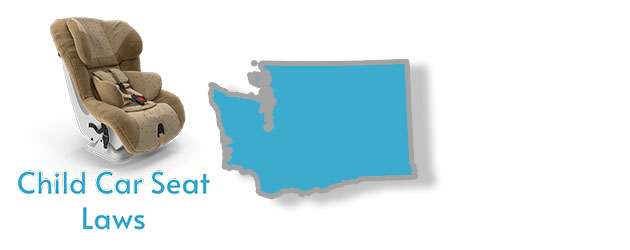A Summary of Child Car Seat Laws in Washington State
- Washington law requires children under 2 years to ride on rear-facing child restraint systems.
- The law allows children of ages 2-4 years to ride on forward-facing seats equipped with a harness.
- Children who have exceeded the forward-facing limits or those who are 4 years or older are required to ride on child booster seats until they are 4’9’’ or taller.
- The law requires children younger than 13 years to ride in the back seat.
Rear-facing Car Seat Laws in Washington
Washington law requires children under 2 years to ride on rear-facing child restraint systems. The law also says children may continue to ride on rear-facing seats until they exceed the manufacturer’s weight and height limits. The rear-facing position is the safest for newborns and infants. In the event of a frontal collision, children can be thrown forward resulting in a huge amount of stress being exerted on the child’s fragile neck and spine. Rear-facing seats prevent such situations by cradling the baby’s head, neck, and spine and also by absorbing most of the impact forces. Newborns can start riding on infant-only seats right from birth. These seats are portable (can double as infant-carriers) and are designed to perfectly fit smaller infants. However, they have lower weight limits (up to 30 pounds), so most infants usually outgrow them before their first birthday. When this happens, children should transition to convertible seats which have a higher weight limit (up to 40 pounds or more), and allow them to remain rear-facing for a longer period. Children can remain rear-facing until age 4, depending on their seat’s weight limit. Rear-facing seats should be secured in the back seat according to the manufacturer’s instructions.
Forward-Facing Car Seat Laws in Washington
The law allows children of ages 2-4 years to ride on forward-facing seats equipped with a harness until they exceed the car seat manufacturer’s weight and height limit. There are many types of forward-facing seats, however, the most common are forward-facing only seats, combination, and convertible seats. For convertible seats, once your child exceeds the rear-facing requirements, the seat can be turned around to face forward. Ensure your child is fastened to the seat with the harness straps. The straps should lie flat over the child’s shoulders such that no more than one finger can fit in between the shoulder and harness strap. A correctly adjusted harness helps in spreading crash forces across the child’s stronger body parts (shoulders and pelvis) and away from the fragile body parts. Forward-facing seats can be used together with a latch system, lap-only belt, or lap-shoulder belts. Most seats can accommodate children of up to 65 pounds, therefore, children can reach age 7 while still within the manufacturer’s limits.
Booster Seat Regulations in Washington
By law, children who have exceeded the forward-facing limits or those who are 4 years or older are required to ride on child booster seats until they are 4’9” or taller. Also, the law requires children to remain in booster seats until the vehicle’s lap-shoulder belts fit properly. This typically happens when the child is between 8-12 years of age. Booster seats are used to lift children so that regular safety belts can fit correctly. The lap portion should lie snug across the upper thighs, and the shoulder portion should lie flat across the center of the chest area. There are two main types of booster seats – high back and no -back. A high back provides more support as it can be used to support a child’s head and neck when there are no headrests and also has a back that helps in holding a child in an upright position, especially when he or she is napping. No-back seats are used when the back seats are equipped with headrests. Before your child transitions to lap-shoulder belts only, ensure that he or she is tall enough (height of 4’9”). A child with the right height should be able to sit all the way back against the seat and with knees bent at the edge of the seat without slouching. Also, the child should be able to travel without trying to detach the safety belt.
Requirements for children to use the front seat in Washington
The law requires children younger than 13 years to ride in the back seat when it is practical to do so. However, if you must place a child safety seat in the front seat or ride with a child in the front seat, make sure to disable the passenger-side airbags because they can be lethal to children when they deploy.
Law on Leaving a child in a car in Washington
It is illegal to leave a child under the age of 16 years unsupervised inside a car. RCW 46.61.685
Law on Smoking in a car with a child in Washington
There is no law regarding smoking in a car with child passengers. We do not recommend smoking in your vehicle with children present.
Car Seat Law Exemptions in Washington
Vehicles for hire and those designed to transport less than 17 passengers by auto transportation companies are not required to comply with the state’s car seat laws. School buses and vehicles providing shuttle services between parking, hotel facilities, airport terminals, and conventions are exempted.
Law on Car Seat Replacement in Washington
There is no law regarding the replacement of car seats. However, the National Highway Traffic Safety Administration says car seats should be replaced after a moderate or severe crash. Car seats should also be replaced after they are past their expiry dates.
More Washington Laws
